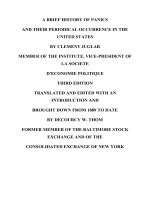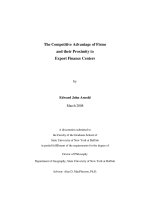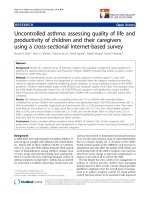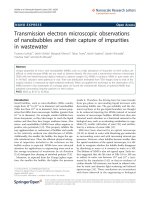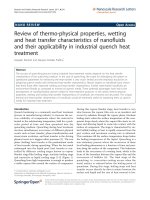Compatibility of fungal and bacterial bio-agents and their antagonistic effect against fusarium oxysporum f. Sp. Lycopersici
Bạn đang xem bản rút gọn của tài liệu. Xem và tải ngay bản đầy đủ của tài liệu tại đây (445.37 KB, 12 trang )
Int.J.Curr.Microbiol.App.Sci (2018) 7(7): 2305-2316
International Journal of Current Microbiology and Applied Sciences
ISSN: 2319-7706 Volume 7 Number 07 (2018)
Journal homepage:
Original Research Article
/>
Compatibility of Fungal and Bacterial Bio-Agents and their Antagonistic
Effect against Fusarium oxysporum f. Sp. Lycopersici
Harshita*, A. Sinha, J.B. Khan, S. Trivedi, A. Verma and S.G. Rao
Department of Plant Pathology, Chandra Shekhar Azad University of Agriculture and
Technology, Kanpur, U.P, India-208002, India
*Corresponding author
ABSTRACT
Keywords
Fusarium oxysporum f.
sp. lycopersici,
Trichoderma harzianum,
Bacillus subtilis,
Pseudomonas
fluorescens,
Compatibility,
Antagonistic activity.
Article Info
Accepted:
17 June 2018
Available Online:
10 July 2018
Fusarium oxysporum f. sp. lycopersici causing tomato wilt is a common soil borne fungus.
Bio-control agents could be used as an eco-friendly approach to effectively control the
disease and may be advised to the farmers for profitable organic farming. The fungal
(Trichoderma harzianum) and bacterial (Bacillus subtilis and Pseudomonas fluorescens )
biological control agents were tested for their compatibility in vitro to determine whether
they can be used in combination. Absence of inhibition zone indicated that the biocontrol
agents were compatible with each other. Trichoderma harzianum, Bacillus subtilis and
Pseudomonas fluorescens were tested in-vitro for their antagonistic activity against
Fusarium oxysporum f.sp. lycopersici. The antagonistic potentiality of Trichoderma
harzianum was determined by 25.4% percent inhibition of the growth of the fungal
pathogen (F. oxysporum lycopersici) in presence of bio-control agent (T.harzianum) and
the antagonistic activity of bacterial bio-control agents revealed maximum Zone of
Inhibition (ZOI) with Bacillus subtilis (29.9 mm) followed by Pseudomonas fluorescens
(25.6 mm).
Introduction
Tomato (Solanum lycopersicum L.) is one of
the most popular and widely grown vegetable
crops in the world. In 2014, world production
of tomatoes was 170.8 million tonnes, with
China accounting for 31% of the total,
followed by India. The worldwide, tomato
productivity is 33.9 MT/ha. In India, tomato
occupies an area of 0.88 M ha having the
production of 18.26 MT. However, the
productivity is only 21.2 MT/ha (Anonymous,
2014). Fusarium wilt of tomato caused by
Fusarium oxysporum f. sp. lycopersici causes
serious economic loss (Agrios, 2005). The
estimated economic losses range from 10 to
80 percent yield loss in tomato producing area
of the country (Keshwan and Chaudhary,
1977). The disease is systemic in nature and
the pathogen may infect plants at any growth
stage. The pathogen is soil as well as seedborne in nature and causes vascular wilts by
infecting plants through the roots and growing
internally through the cortex to the stele
2305
Int.J.Curr.Microbiol.App.Sci (2018) 7(7): 2305-2316
(Bowers and Locke, 2000) thereby causing
xylem browning or blackening. The pathogen
can survive in the soil up to 6 years even in
the absence of a host plant.
It is important to investigate the potential of
biological control agents in agriculture as
these are highly effective, inexpensive with
excellent shelf life and serve as a suitable
alternative to chemical applications with
sustainable disease management without
pesticides residues in food stuffs, development
of resistance in plant pathogens and
appearance of new strains of pathogens. The
natural control of several phytopathogens is
based on the presence of suppressive soils
where several biocontrol microorganisms
belonging to Trichoderma, Pseudomonas and
Bacillus genera are detected (Weller et al.,
2002 and Huang et al., 2005).Numerous
bacteria and fungi, including Trichoderma
isolates, or combinations of microorganisms,
collected from field tomato plants have proved
to be effective in controlling Fusarium wilt in
tomato (Larkin and Fravel, 1998; Srivastava et
al., 2010).
Prospects of biological control of soil-borne
plant pathogens using the genus Trichoderma,
as one of the promising bio-control agent, has
been described (Morsy et al., 2009; Sabalpara
et al., 2009). Successful control of Fusarium
wilt in many crops by application of different
species of Trichoderma has been reported
(Bell et al., 1982; Ramezani, 2009). They can
also compete with other microorganisms; for
example, they compete for key exudates from
seeds that stimulate the germination of
propagules of plant- pathogenic fungi in soil
and, more generally, compete with soil
microorganisms for nutrients and/ or space
(Chet, 1987).
B. subtilis also produces a variety of
biologically active compounds with a broad
spectrum of activities toward phytopathogens
and that are able to induce host systemic
resistance (Bais et al., 2004; Stein, 2005;
Butcher et al., 2007; Nagorska et al., 2007;
Ongena et al., 2007; Ongena and Jacques,
2008). Various strains of B. subtilis have also
been shown to be capable of forming
multicellular structures or biofilms (Branda et
al., 2001; Hamon and Lazazzera, 2001; Bais et
al., 2004). Due to these beneficial traits, B.
subtilis is potentially useful as a biological
control agent.
Among biocontrol agents, root-associated
fluorescent Pseudomonas spp. has also
received special attention because of its
excellent root colonizing ability, potential to
produce a wide variety of anti-microbial
metabolites, and its induction of systemic
resistance (Erdogan and Benlioglu, 2010).
Several studies have shown their efficacy as
an inoculum (Kloepper et al., 1980;
Thomashow and Weller, 1995; Lugtenberg
and Dekkers et al., 1999; Whipps, 2001;
Weller et al., 2002; Achouak et al., 2004;
Hariprasad and Niranjana, 2009; Validov et
al., 2009). Liquid formulation of P.
fluorescens Pf1 exhibited higher induction of
defense enzymes and reduced the incidence of
tomato Fusarium wilt disease (Manikandan
and
Raguchander,
2014).
Fluorescent
Pseudomonas bacteria have been shown to act
against pathogenic agents by synthesizing
antibiotic compounds (e.g., Phenazins,
Pyrrolnitrine and 2,4- Diacetyl fluoro
glucinol) (Keel et al., 1992), hydrogen
cyanide (Maurhofer et al., 1995), lytic
enzymes capable of altering the fungal cell
wall (Chitinase and Glucanase) and other
secondary metabolites (O’Sullivan and
O’Gara, 1992). In addition to the antibiotic
properties and the trophic competition
recognized in these rhizobacteria, there is
evidence that fluorescent Pseudomonas strains
can trigger Induced Systemic Resistance (ISR)
in plants, thus assuring a protection against a
broad spectrum of phytopathogen agents (Van
2306
Int.J.Curr.Microbiol.App.Sci (2018) 7(7): 2305-2316
Loon et al., 1998). With this background
information, the present investigation was
undertaken to evaluate the compatibility of
fungal and bacterial bio-agents and their
antagonistic
effect
against
Fusarium
oxysporum f. sp. lycopersici.
Materials and Methods
An In vitro experiment was conducted in the
Bio-control Laboratory of Plant Pathology
Discipline, Chandra Shekhar Azad University
of Agriculture And Technology, Kanpur, U.P.
to assess the compatibility among P.
fluorescens, Bacillus subtilis and Trichoderma
harzianum in order to determine whether they
can be used in combination. Thereafter In
vitro experiments to assess antagonistic effect
of each of these biocontrol agents against F.
oxysporum f. sp. lycopersici were also
conducted.
avoid any chance of contamination. Thus, pure
cultures of the fungi growing on these root
pieces were prepared. For each fungal colony
separate slant was used.
For identification of different fungi/ pathogens
the colonies of different fungi growing on
potato dextrose agar medium were examined
under Light microscope (Olympus). Based on
colony colour and growth and type of
mycelium, sclerotia and the spores produced,
tentatively the colonies of different pathogens
were separated. Later on the slides of the
pathogens having dark colour colonies were
prepared in lactophenol only and of those
having cottony white colonies apparently,
looking as those of Fusarium were prepared
with lactophenol- cotton blue stain. The
Fusarium cultures were separated on PDA
medium based on their colony colour, pattern,
spore morphology and the conidiophores etc.
as described by Booth (1971).
Survey, collection, isolation, purification
and identification of fungal pathogen
The tomato plants showing typical wilt
symptoms were collected from farmer’s fields
of Kalayanpur, Mandhana and Chaubeypur
blocks of Kanpur district. The diseased plants
were uprooted, packed in polybags and
brought to Bio-control lab for isolation.
Roots of infected tomato plants were cut into
small pieces and surface sterilized with 1%
Sodium hypoclorite solution for 1 minute.
Isolations were made on Petri plates poured
with PDA by placing the sterilized root pieces
under aseptic conditions using laminar air
flow cabinet. These inoculated Petri plates
were incubated at 25 ±1ºC in a BOD
(Biological Oxygen Demand) incubator. As
soon as the growth of pathogens occurred,
with the help of the sterilized needle a hyphal
bit from the periphery of the growing fungal
colony was transferred onto a potato dextrose
agar slant, in the laminar air flow cabinet to
Isolation, purification and identification of
Trichoderma sp.
Soil samples from 5-6 cm depth were
collected from farmer’s fields of Kalayanpur,
Mandhana and Chaubeypur blocks of Kanpur
district in polythene bags. Five soil samples
were collected from each location.
For isolation of Trichoderma strains, Serial
dilution technique (Johnson and Curl, 1972)
on Trichoderma selective medium (Elad et al.,
1981) was followed.
Ten gram soil sample from well pulverized,
air dried soil was added into 90mL sterile
water in a flask to make 1:10 dilution (10-1).
The mixture was vigorously shaken on a
magnetic shaker for 20-30 minutes to obtain
uniform suspension. One ml of suspension
from flask was transferred into a test tube
containing 9mL sterile water under aseptic
2307
Int.J.Curr.Microbiol.App.Sci (2018) 7(7): 2305-2316
condition to make 1:100 (10-2) dilution.
Further dilution 10-3 was made by pipetting
1mL suspension into additional water as
prepared above. One mL each liquids of 10-3
dilution were transferred into 10 sterile Petri
plates, which was previously poured by 15mL
sterile PDA medium and spread uniformly.
The Petri plates were incubated at 25 ± 10C
for 7 days in an incubator. As soon as the
mycelial growth were visible in the PDA
culture medium, the hyphal tips from the
advancing mycelium were cut and transferred
into the culture slants containing PDA
medium for further purification and
identification of culture. The pure culture of
Trichoderma sp. was obtained by adopting
single spore technique. Trichoderma isolate
was identified by light microscope for
morphological characters such as the
branching pattern of conidiophore, the
conidiophore apex elongation, phialides shape,
size, structure, and conidial shape, using the
available literature (Bisset, 1991).
Isolation
of
antagonistic
bacteria
(Pseudomonas fluorescens and Bacillus
subtilis)
Serial dilution technique (Johnson and
Curl, 1972) was adapted for isolation of
Bacillus and Pseudomonas sp. from
rhizospheric soil samples collected from
tomato eco-system. One gram of air-dried soil
samples were weighed and suspended in 9mL
sterilized distilled water and stirred well.
Isolation of Pseudomonas sp.
For isolation of Pseudomonas sp. one ml of
the soil suspension at 105, 106, 107 dilution
was spread on Petri plates poured with
Pseudomonas specific medium known as
King’s B medium (Hi media) (King et al.,
1954).
The plates were incubated at 30°C for 48 h.
Pseudomonas colonies were picked from the
medium and sub-cultured onto Nutrient Agar
slant.
Isolation of Bacillus sp.
For isolation of Bacillus sp., Nutrient Agar
medium (Sigma Al-drich) was used. The
plates were incubated at 30°C for 48 h.
Bacillus colonies were picked from the
medium and sub-cultured onto Nutrient Agar
slant.
For identification of bacterial bio-agents, two
techniques were adopted viz. visual
observation on Petri dishes and micromorphological studies. Observation of colony
morphology was done such as the shape, size,
texture, colony surface markings, elevation,
margin type, consistency, colour, translucency
or opaqueness and presence of pigments,
precipitates or crystals in the medium. For
micro-morphological studies, Gram staining
method (Gram, 1884) was used. First of all a
bacterial smear was prepared on greeze free
clean slide, dried in air and then fixed by heat.
Staining was done with ammonium oxalate
crystal violet for 1 min and then washed in
gently in tap water. It is then decolorized with
gentle agitation in 95% ethyl alcohol for 30 s,
till the blue colour ceased to come out
.Further, it is counter stained with Safranine
solution for 10s, washed in tap water, dried
and examined under the oil immersion
objective of the microscope. Appearance of
red color revealed the Gram negative nature of
the bacterium (Pseudomonas sp.) and that of
violet color revealed Gram positive nature of
the bacterium (Bacillus sp.). Cell shape,
arrangements, flagellation etc. were also seen
the under light microscope.
For identification at species level purified
cultures of fungal and bacterial bio-agents
were send to ITCC, New Delhi. Based on the
2308
Int.J.Curr.Microbiol.App.Sci (2018) 7(7): 2305-2316
identification report the fungal and bacterial
bio-agents were identified as Trichoderma
harzianum, Pseudomonas fluorescens and
Bacillus subtilis were used for further studies.
Compatibility among fungal and bacterial
bioagents
In vitro compatibility test between P.
fluorescens and T. harzianum or Bacillus
subtilis and T. harzianum using Dual culture
plate method described by Siddiqui and
Shaukat (2003) was employed.
Accordingly, an overnight culture of P.
fluorescens and Bacillus subtilis grown on
Nutrient broth streaked on one side of a Petridish containing PDA. The other side of the
petri-dish was inoculated with 5mm disc of T.
harzianum (9 days old). The plates were then
incubated at 25±1oC and zone of inhibition (if
any) was measured. The test was performed in
triplicates.
In vitro screening of fungal bio-agent
(Trichoderma harzianum) against Fusarium
oxysporum f.sp. lycopersici
To assess in vitro effect of T. harzianum
against F. oxysporum f. sp. lycopersici a
laboratory bioassay using Dual culture
technique (Morton and Stroube, 1955) was
used. The antagonistic activity of T.
harzianum against F. oxysporum f. sp.
lycopersici was tested using PDA medium.
Five mm disc from 7 days old culture of the
pathogen was placed on one end of the Petri
dish with the help of sterilized inoculation
needle and one day later, 5 mm disc from
antagonist culture was inoculated at opposite
side, since, T. harzianum was fast growing.
Petri plates without antagonist served as
control. Experiment was replicated thrice.
Observations were recorded up to 72 h. and
percent growth inhibition was calculated using
following formula - Vincent (1927).
Percent growth inhibition =
Compatibility
between
Pseudomonas
fluorescens and Bacillus subtilis
The isolates of Pseudomonas fluorescens and
Bacillus subtilis were tested for their
compatibility among each other following the
method of Fukui et al., (1994).
The compatibility was determined for P.
fluorescens and B. subtilis strains using
Nutrient Agar medium.
The bacterial strains were streaked
horizontally and vertically to each other. The
plates were incubated at room temperature
(28±2°C) for 72h and observed for the
inhibition zone.
Absence of inhibition zone indicated the
compatibility with respective bacterial strains
and the presence of inhibition zone (if any)
indicated the incompatibility.
Growth in control - Growth in treatment X100
Mycelial growth in control
In vitro screening of bacterial bio-agents
(Pseudomonas fluorescens and Bacillus
subtilis) against Fusarium oxysporum f. sp.
lycopersici
Agar well diffusion method is widely used to
evaluate the antimicrobial activity of plants or
microbial extracts. The antagonistic activity of
Pseudomonas fluorescens and Bacillus subtilis
against Fusarium oxysporum f. sp. lycopersici
was tested using Well Diffusion Technique
(Magaldi, 2004; Valgas, 2007). Twenty mL of
PDA media was poured on glass Petri plates
and allowed to solidify. The agar plate surface
was then inoculated by spreading 1 mL of
Fusarium oxysporum lycopersici suspension
over the entire agar surface. Then, 4 holes
with a diameter of 5 mm were punched
2309
Int.J.Curr.Microbiol.App.Sci (2018) 7(7): 2305-2316
aseptically with a sterile cork borer ensuring
proper distribution of holes in the periphery
and the bacterial bio-agents (suspension
having cfu 2x108/mL) were introduced into
the wells in different plates. The petri plates
without antagonist (Pseudomonas fluorescens
and Bacillus subtilis) served as control. The
plates were incubated at 25 ± 10C for 5 days
and observed for the inhibition zone.
Experiment was replicated thrice. The
bacterial bio-agent diffuses in the agar
medium and inhibits the growth of the
pathogen creating a zone of inhibition. The
diameter of the zones of inhibition was
measured with scale.
Results and Discussion
Compatibility
of
T.harzianum
with
Pseudomonas fluorescens and with Bacillus
subtilis
The fungal and bacterial antagonist found
potential against Fusarium oxysporum f. sp.
lycopersici were tested for their compatibility
in vitro as described in “Materials &
Methods”. Absence of inhibition zone around
the disk indicated that these two bacterial biocontrol agents were compatible with T.
harzianum (Fig. 1).
Compatibility
between
Pseudomonas
fluorescens and Bacillus subtilis
The two bacterial antagonists found potential
against Fusarium oxysporum f. sp. lycopersici
were tested for their compatibility in vitro as
described in “Materials & Methods”. Absence
of inhibition zone indicated that these two
bacterial biocontrol agents were compatible
with each other (Fig. 2).
Antagonistic activity of T. harzianum
against Fusarium oxysporum f. sp.
lycopersici (Dual culture technique)
Trichoderma inhibited the growth of
Fusarium oxysporum f. sp. lycopersici through
its ability to grow much faster than the
pathogenic fungi thus competing efficiently
for space and nutrients. The antagonistic
potentiality of Trichoderma harzianum was
determined by dual culture technique as
described in “Materials and Methods”. The
results are interpreted in terms of percent
inhibition of the growth (25.4%) of the fungal
pathogen (F. oxysporum lycopersici) in
presence of bio-control agent (T.harzianum)
and presented in Table 1 and Figure 3 and 4.
Table.1 Percent inhibition of F.oxysporum lycopersici in presence of T. harzianum
Treatment
Radial growth of pathogen*
Percent inhibition in growth
(mm)
Fol + Th
39.3
25.4
Control
52.7
-
SE
1.5
CD @ 5 %
5.1
* Mean of three replications; Fol – Fusarium oxysporum f. sp. lycopersici; Th – Trichoderma
harzianum.
2310
Int.J.Curr.Microbiol.App.Sci (2018) 7(7): 2305-2316
Table.2 Antagonistic activity of bacterial bio-agents against Fusarium oxysporum f. sp.
lycopersici recorded in terms of ZOI (Zone of Inhibition)
Treatment
Fol+Pf
Fol+Bs
cfu/ml
2X108
2X108
ZOI (mm)*
25.6
29.9
* Mean of three replications
Fol – Fusarium oxysporum f. sp. lycopersici
Pf- Pseudomonas fluorescens
Bs-Bacillus subtilis
Fig.1(A) Compatibility of T.harzianum with B.subtilis (B) Compatibility of T.harzianum with
P.fluorescens
A
B
Fig.2 Compatibility of Pseudomonas fluorescens with Bacillus subtilis
2311
Int.J.Curr.Microbiol.App.Sci (2018) 7(7): 2305-2316
Fig.3(A) Control (B) Antagonism of T. harzianum against F. oxysporum f. sp. lycopersici (Dual
Culture)
A
B
Fig.5 Antagonism of Bacterial bio-agents against F. oxysporum f.sp. lycopersici (Well Diffusion
Technique) (A) Bacillus subtilis (B) Pseudomonas fluorescens
A
B
2312
Int.J.Curr.Microbiol.App.Sci (2018) 7(7): 2305-2316
Fig.4 Percent inhibition of Fusarium oxysporum fsp lycopersici in presence of T.
harzianum
Antagonistic activity of bacterial biocontrol agents (Pseudomonas fluorescens
and bacillus subtilis) against Fusarium
oxysporum f. sp. lycopersici (Well Diffusion
Technique)
The results of antagonistic activity of
bacterial bio-control agents (Bacillus subtilis
and Pseudomonas fluorescens) are presented
in table 2 and figure 5. Data presented in table
2 clearly indicated that maximum Zone of
Inhibition (ZOI) was recorded with Bacillus
subtilis as 29.9 mm followed by Pseudomonas
fluorescens as 25.6 mm.
References
Abeysinghe, S., (2009).Effect of combined use
of Bacillus subtilis CA32 and
Trichoderma harzianum RU01 on
biological control of Rhizoctonia solani
on Solanum melongena and Capsicum
annuum.Plant Pathology J ., 8: 916.
Achouak, W, Conrod, S, Cohen, V and Heulin
T. (2004). Phenotypic variation of
Pseudomonas brassicacearum as a plant
root colonization strategy. Molecular
Plant Microbe Interactions,17: 872–
879.
Agrios, G. N. (2005). Plant Pathology. (5th
Edition).Elsevier Academic Publishers,
Boston. 922pp.
Anonymous
(2014).Indian
Horticulture
Database. National Horticulture Board,
Ministry of Agriculture, Government of
India, Gurgaon, U.P., India: 181.
Bais
HP,
Fall
R.
and
Vivanco
JM.(2004).Biocontrol
of
Bacillus
subtilis against infection of Arabidopsis
roots by Pseudomonas syringae is
facilitated by biofilm formation and
surfactin production. Plant Physiol.,
134: 307–319.
Bell, D. K., Wells, H.D. and Markhan, C.R.
(1982).
Invitro
antagonism
of
Trichoderma species against six fungal
pathogens. Phytopathology,72: 379-382.
Bisset, J. (1991). A revision of the genus
Trichoderma
II.
Infragenric
classification, Can. J. Bot., 69: 23732417.
Booth, C. (1971). The genus Fusarium.
Commonwealth Mycological Institute
Kew, Surrey, U. K. 237pp.
Bowers JH, and Locke JC (2000). Effect of
botanical extracts on the population
density of Fusarium oxysporum in soil
and control of Fusarium wilt in the
greenhouse. Plant Dis.,84:300–305.
Branda SS, Gonzalez Pastor JE, BenYehuda S,
Losick R, and Kolter R.(2001)Fruiting
body formation by Bacillus subtilis.
Proc. Nat.l Acad. Sci. USA.;98:11621–
11626.
Butcher RA, Schroeder FC, Fischbach MA,
Straightt PD, Kolter R, Walsh CT, and
2313
Int.J.Curr.Microbiol.App.Sci (2018) 7(7): 2305-2316
Clardy J (2007).The identification of
bacillaene, the product of the PksX
megacomplex in Bacillus subtilis. Proc.
Natl. Acad. Sci.USA., 104:1506–1509.
Chaube, H. S. and Sharma, J. (2002).Integration
and interaction of solarization and
fungal and bacterial bioagents on
disease incidence and plant growth
response of some horticultural crops.
Plant Disease Research, 17: 201.
Chet, I. (1987).Trichoderma application, mode
of action, and potential as a biocontrol
agent of soil borne plant pathogenic
fungi. In: Innovative approaches to
plant disease control (Ed. Chet, I.),John
Wiley and Sons, New York. 137-160pp.
Elad Y., Chet I. and Henis Y. (1981).A
selective medium for improving
quantitative isolation of Trichoderma
spp. from soil.Phytoparasitica,9:59-67.
Erdogan O, and Benlioglu K (2010). Biological
control of Verticillium wilt on cotton by
the use of fluorescent Pseudomonas spp.
under
field
conditions.
Biol.
Control,53:39–45.
Fukui R, Schroth MN, Hendson M, and
Hancock JG (1994).Interaction between
strains of Pseudomonads in sugar beet
spermospheres and the relationship to
pericarp colonization by Pythium
ultimum
in
soil.Phytopathology,84:1322–1330.
Gram, H.C. (1884).Uber die isolierte Farbung
der Schizomyceten in Schnitt- und
Trockenpraparaten. Fortschritte der
Medizin, 2: 185–189.
Hamon MA. and Lazazzera BA.(2001). The
sporulation transcription factor Spo0A
is required for biofilmdevelopment in
Bacillus
subtilis.
Mol.Microbiol.
2001;42:1199–1209.
Hariprasad, P. and Niranjana, S.R. (2009).
Isolation and characterization of
phosphate solubilizing rhizobacteria to
improve plant health of tomato. Plant
Soil,316: 13-24.
Huang, D, Ou, B, and Prior, RL. (2005).The
chemistry behind antioxidant capacity
assays. J. Agric. Food Res.,53: 1841–
1856.
Jetiyanon,
K.
and
J.W.
Kloepper,
(2002).Mixtures of plant growth
promoting rhizobacteria for induction of
systemic resistance against multiple
plant diseases.Biol.Cont.,24:285-291.
Johnson L.F. and Curl E.A. (1972). Methods for
research on the ecology of soil borne
plant pathogens. Burgess Publishing
Company Minneapolis. 247pp.
Kapoor, A. S. (2008).Biocontral potential of
Trichoderma sp. against important soil
borne diseases of vegetable crops.
Indian Phytopath.,61 (4):492-498.
Keel C, Schnider U, Maurhofer M, Voisard C,
Laville J, Burger U, Wirthner P, Haas
D. and Defago G (1992). Suppression of
root
diseases
by
Pseudomonas
fluorescens CHAO: importance of
bacterial secondary metabolite, 2,4diacetylphoroglucinol. Mol. PlantMicrobe Interact. 5:4-13.
Keshwan, V. and Chaudhary B. (1977).
Screening for resistance to Fusariumwilt
of tomato. SABRO J.,9: 51-65.
King E.O., Ward M.K. and Raney D.E. (1954).
Two
simple
media
for
the
demonstration of pyocyanin and
fluorescin. J. Lab. Clin. Med., 44, 301307.
Kloepper JW, Leong J, Teintze M, and Schroth
MN (1980b). Enhanced plant growth by
siderophores produced by plant growthpromoting
rhizobacteria.
Nature,286:835–836.
Larkin, R. P. and Fravel, D. P. (1998). Efficacy
of various fungal and bacterial
biocontrol organisms for control of
Fusarium wilt of tomato. Pl. Dis., 82:
1022-1028.
Lathaa,P.,
Ananda,T.,
Prakasama,
V.
,Jonathanb, E.I., Paramathmac, M., and
Samiyappana, R.,(2011). Combining
Pseudomonas,
Bacillus
and
Trichoderma strains with organic
amendments and micronutrient to
enhance suppression of collar and root
rot disease in physic nut. Applied Soil
Ecology ,49:215–223.
2314
Int.J.Curr.Microbiol.App.Sci (2018) 7(7): 2305-2316
Lugtenberg B.J., and Dekkers L.C. (1999).
What makes Pseudomonas bacteria
rhizosphere
competent.
Environ
Microbiol.
Lugtenberg
B.J.,
Kravchenko L.V., Simons M. Tomato
seed and root exudate sugars:
composition,
utilization
by
Pseudomonas biocontrol strains and role
in rhizosphere colonization. Environ.
Microbiol ., 1:439–446.
Magaldi, S., Mata-Essayag, S., Hartung, de,
Capriles, C., Perez, C., Colella, M.T.,
Olaizola, C., and Ontiveros, Y. (2004).
Well
diffusion
for
antifungal
susceptibility testing.Int. J. Infect.Dis.,
8(1):39-45.
Manikandan, R., and Raguchander, T. (2014).
Fusarium oxysporum f. sp., lycopersici
retardation through induction of
defensive response in tomato plants
using a liquid formulation of
Pseudomonas fluorescens (Pf1). Eur. J.
Plant Pathol, 140, 469–480 .
Maurhofer, M., Hase, C., Meuwly, P., Metraux,
J.P. and Defago, G. (1994). Induction of
systemic resistance of tobacco to
tobacco necrosis virus by the rootcolonizing Pseudomonas fluorescens
strain CHAO. Influence of the gcaA
gene and pyoverdine production.
Phytopathology, 84: 139–146.
Morsy E.M., Abdel-Kawi K.A., and Khalil
M.N.A. (2009) Efficacy of
Trichoderma viride and Bacillus subtilis
as biocontrol agents against Fusarium
solani on tomato plants. Egypt. Journal
of Plant Pathology,37(1): 47-57.
Morton, D. T. and
Stroube, W. H.
(1955).Antagonistic and stimulatory
effects
of
microorganism
upon
Sclerotium rolfsii.Phytopatholgy, 45:
419-420.
Nagorska K, and Bikowski M, Obuchowskji M.
(2007). Multicellular behaviour and
production of a wide variety of toxic
substances support usage of Bacillus
subtilis as a powerful biocontrol agent.
Acta Biochimica Polonica,54:495–508.
O’Sullivan DB, and O’Gara F. (1992). Traits of
fluorescent Pseudomonas spp. involved
in suppression of plant root pathogens.
Microbiol Rev, 56:662-676.
Ongena M and Jacques P. (2008).Bacillus
lipopeptides: versatile weapons for plant
disease
biocontrol.
Trends
Microbiol.:16:115–125.
Ongena M, Adam A, Jourdan E, Paquot M,
Brans A, Joris B, Arpigny JL, and
Thonart P. (2007) . Surfactin and
fengycin lipopeptides of Bacillus
subtilis as elicitors of induced systemic
resistance
in
plants.
Environ.Microbiol.,9:1084–1090.
Ramezani H., (2009). Efficacy of some fungal
and
bacterial
bioagents
against
Fusarium oxysporum f.sp.ciceri on
chickpea. Plant Prot J, 1: 108-113.
Rini, C. R. and Sulochana, K. K. (2006).
Management of seedling rot of chilli
(Capsicum
annuum
L.)
using
Trichoderma spp. and fluorescent
pseudomonads
(Pseudomonas
fluorescens). J. Trop. Agri., 44: 79-82.
Sabalpara A.N., Priya J., Waghunde R.R.,
Pandya J.P., (2009). Antagonism of
Trichoderma against sugarcane wilt
pathogen
(Fusarium
moniliformae).American-Eurasian
J.
Agric. Environ. Sci., 3(4): 637-638.
Siddiqui,
I.A
and
Shaukat,
S.S.
(2003).Combination of Pseudomonas
aeruginosa
and
Pochonia
chlamydosporia for control of rootinfecting fungi in tomato. Journal of
Phytopathology, 151: 215-222.
Srivastava , R., A. Khalid, U.S. Singh and A.K.
Sharma,
(2010).Evaluation
of
arbuscular
mycorrhizal
fungus,
fluorescent
Pseudomonas
and
Trichoderma harzianum formulation
against Fusarium oxysporum f. sp.
lycopersici for the management of
tomato wilt. Biological Control, 53, 2431.
Stein, T. (2005). Bacillus subtilis antibiotics:
structures, syntheses and specific
functions. Mol. Microbiol., 56: 845–
857.
2315
Int.J.Curr.Microbiol.App.Sci (2018) 7(7): 2305-2316
Sunita, J., Waghtnare, V., Datar V. and
Vaishali, Zote K. (2008).Antagonistic
effect of Trichoderma sp. against
Fusarium oxysporum f. sp. carthami
causing wilt of safflower.Indian
Phytopath., 61(3): 374.
Thaware, D.S., Kohire, O.D. and Gholve, V.M.
(2017). In vitro efficacy of fungal and
bacterial antagonists against Fusarium
oxysporum f. sp. ciceri causing chickpea
wilt. Int.J.Curr.Microbiol.App.Sci 6(1):
905-909.
Thomashow, L.S. & Weller, D.M. (1995)
Current concepts in the use of
introduced bacteria for biological
disease control: mechanisms and
antifungal metabolites. Plant–Microbe
Interactions, Vol. 1 (Stacey G & Keen
N, eds), Chapman & Hall, New York,
NY, Pp. 187-235.
Valgas, C., Souza, S. M. D., Smania, E. F. A. ,
Jr., and A. S. N. (2007). Screening
methods to determine antibacterial
activity of natural products.Braz. J.
Microbiol, 38: 369-380.
Validov S.Z., F. Kamilova and B.J.J.
Lugtenberg,
(2009).Pseudomonas
putida strain PCL1760 controls tomato
foot and root rot in stonewool under
industrial conditions in a certified
greenhouse. Biological Control, 48: 6–
11.
Van Loon, L.C, Bakker, PAHM, and Pieterse,
CMJ (1998). Systemic resistance
induced by rhizosphere bacteria. Annu
Rev Phytopathol, 36: 453–483.
Vincent, J.M. (1927). Distribution of fungal
hyphae in the presence of certain
inhibitors. Nature, 159(4051): 850.
Weller DM, Raaijmakers JM, McSpadden
Gardner BB, and Thomashow LS.
(2002).
Microbial
populations
responsible
for
specific
soil
suppressiveness to plant pathogens.
Annual Review of Phytopathology, 40:
308–348.
Weller DM, Raaijmakers JM, McSpadden
Gardner
BB,
and
Thomashow
LS.(2002).
Microbial
populations
responsible
for
specific
soil
suppressiveness to plant pathogens.
Annual Review of Phytopathology, 40:
308–348.
Whipps, J.M. (2001).Microbial interactions and
biocontrol in the rhizosphere. Journal of
Experimental Botany, 52: 487-511.
How to cite this article:
Harshita, A. Sinha, J.B. Khan, S. Trivedi, A. Verma and Rao, S.G. 2018. Compatibility of Fungal
and Bacterial Bio-agents and their Antagonistic Effect against Fusarium oxysporum f. Sp.
Lycopersici. Int.J.Curr.Microbiol.App.Sci. 7(07): 2305-2316.
doi: />
2316


